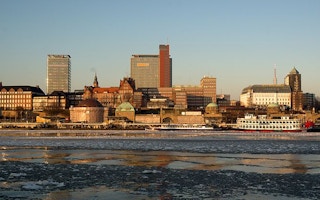Not that long ago, “adaptation” was a bad word among good environmentalists.
That’s because it was seen as conceding defeat in the fight to put a price on carbon pollution, a distraction from the dramatic emissions reductions needed.
But just a few years later, we’re seeing growing interest in “adaptation” — or its more pleasantly-named cousin, “resilience“ — from cities and corporations. Even so, few would argue that climate resilience is routinely prioritized at the necessary scale.
Like many shifts in corporate sustainability’s evolution, scaling adaptation will require disruptive innovation and the changing of whole systems. Most of us, however, feel uncomfortable with dramatic change, while introducing new strategies into corporate cultures may be more than many C-suites want to tackle. The key may be to look at adaptation through a new lens applied to SustainAbility’s leadership triangle, which includes:
- Vision and strategy
- Communication/engagement
- Performance

Envision resilience
A bold vision is a critical linchpin to best-in-class sustainability strategies, such as Unilever’s 2020 goal of halving its environmental impact while growing revenue. Similarly, a strong, inspiring vision of resilience is central to rallying the support and resources necessary to build a climate-smart business.
Without a clear signal that the C-suite prioritizes material climate risks and opportunities, it becomes all too easy to simply deal with more immediate or familiar issues. Climate-smart strategic planning is new for even the most seasoned sustainability practitioners who are going to learn a lot as they make mistakes. It isn’t a comfort zone many will naturally gravitate toward, which means leadership needs to send a clear signal that climate resilience is a top priority.
While defending assets and markets against climate risks is the focus of most vulnerability assessments, few of us are inspired by an inherently defensive mission.
Sell the vision
Climate change is such a daunting crisis that focusing on the downside risks can easily paralyze progress with fear and uncertainty. To effectively communicate a resilience vision and engage stakeholders, firms must balance the urgency to act with an inspiring forward-looking game plan. Looking at engagement through a climate lens will require including future stakeholder who don’t yet feel the climate impacts that are continuing to cut across economic sectors and communities.
Put vision into action
All the vision in the world and the best communication and engagement strategies are no substitute for performance. Viewed through a climate adaptation lens, performance entails a robust process that anticipates climate risks, opportunities and results, including protected assets, innovative growth opportunities and policy engagement.
Weyerhaeuser’s approach to climate impacts, for example, ranges from using LiDAR-sensing technology to monitor forest conditions to collaborating with local universities and government agencies to best identify emerging risks. Meanwhile, in the wake of Hurricanes Katrina and Rita, Entergy worked with Swiss Re to identify specific climate risks and opportunities within key geographies. Entergy then devised a series of specific strategies and projects, from wetland restoration to floating production systems, that can be deployed to increase resiliency across business units.
Leading climate-smart sustainability programs will include all three elements of leadership. Given the threats and opportunities corporations and communities face, rapid learning needs to come from testing strategies now and collaborating within supply chains and across sectors. This will help us identify specific strategies that are best suited to addressing various climate impacts.
Given the brave new and warming world into which we are entering, success is uncertain and mistakes are guaranteed, requiring increased innovation, communication and an embrace of the failure that comes with learning. That said, harnessing ingenuity to solve problems is what great companies do best.
JP Leous is a senior manager in SustainAbility’s DC office and leads client projects across a range of sectors. This article can be found here and originally appeared as part of SustainAbility’s What’s Next column on the Greenbiz.com website.










